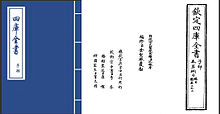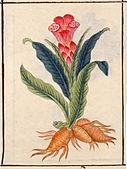Compendium of Materia Medica
This article needs additional citations for verification. (February 2016) |
| Compendium of Materia Medica | |||||||||||||
|---|---|---|---|---|---|---|---|---|---|---|---|---|---|
 The Siku Quanshu edition | |||||||||||||
| Traditional Chinese | 本草綱目 | ||||||||||||
| Simplified Chinese | 本草纲目 | ||||||||||||
| Literal meaning | Principles and Species of Roots and Herbs | ||||||||||||
| |||||||||||||
The Compendium of Materia Medica or Bencao Gangmu (Chinese: 本草綱目), also «Great Pharmacopoeia»[1] — Chinese herbology volume written by Li Shizhen during the Ming dynasty; its first draft was completed in 1578 and printed in Nanjing in 1596. It is a work that lists the materia medica of Chinese medicine known at the time. It lists plants, animals, minerals, that were believed to have medicinal properties.
Name[]
The title, translated as "Materia Medica, Arranged according to Drug Descriptions and Technical Aspects",[2] uses two Chinese compounds. Bencao ("roots and herbs; based on herbs, pharmacopeia, materia medica") combines ben (本 'origin, basis') and cao (草 'grass, plant, herb'). Gangmu (Kang-mu; 'detailed outline; table of contents') combines gang (kang; 綱 'main rope, hawser; main threads, essential principles') and mu (目 'eye, look; category, division').
The characters 綱 and 目 were later used as 'class' and 'order', respectively, in biological classification.
History[]
The text was written by Li Shizhen, who borrowed from the existing writings of Chinese medical scholars at the time. He wrote the first draft of the text in 1578, after conducting readings of 800 other medical reference books and carrying out 30 years of field study. But the final version was only published after he died. At the time, the Ming dynasty emperor did not pay much attention to it.
Content[]
The text consists of 1,892 entries, each entry with its own name called a gang. The mu in the title refers to the synonyms of each name.[3]
The Compendium of Materia Medica has 53 volumes in total:
- At the very beginning is the table of contents, containing a list of entries included and 1,160 hand drawn diagrams to serve as illustrations.
- Volume 1 to 4 – an index (序例) and a comprehensive list of herbs that would treat the most common sickness (百病主治藥).
- Volume 5 to 53 – the main content of the text, containing 1,892 distinct herbs, of which 374 were added by Li Shizhen himself. There are 11,096 side prescriptions to treat common illness (8,160 of which is compiled in the text).
The text is written in almost 2 million Chinese characters, classified into 16 divisions and 60 orders. For every herb there are entries on their names, a detailed description of their appearance and odor, nature, medical function, side effects, recipes, etc.
Evaluation[]
The Ming emperor did not pay much attention to the work at the time it was published. It was only published after Li Shizhen died.
The British historian Joseph Needham writes about the Compendium in his Science and Civilisation in China.[4][5]
With the publication of Compendium of Materia Medica provided classification of how traditional medicine was compiled and formatted, as well as biology classification of both plants and animals.
The compendium corrected some mistakes in the knowledge of herbs and diseases at the time. Several new herbs and more details from experiments were also included. It also has notes and records on general medical data and medical history.
Compendium of Materia Medica includes information on pharmaceutics, biology, chemistry, geography, mineralogy, geology, history, and even mining and astronomy.
Gallery[]

Compendium of Materia Medica is a pharmaceutical text written during the Ming Dynasty of China. This edition was published in 1593.

Illustration from a copy of Compendium of Materia Medica, from 1800

See also[]
- Chinese herbology
- Mellified Man
- Pharmacognosy
- Yaoxing Lun
References[]
- ^ History of Medicine: China / Encyclopædia Britannica // «There were famous herbals from ancient times, but all these, to the number of about 1,000, were embodied by Li Shijen in the compilation of Bencao gangmu (the “Great Pharmacopoeia”) in the 16th century CE.»
- ^ Unschuld (1986), p. 145.
- ^ Zohara Yaniv; Uriel Bachrach (2005). Handbook Of Medicinal Plants. Psychology Press. p. 37. ISBN 978-1-56022-995-7.
- ^ Needham, Joseph, Ho Ping-Yu and Lu Gwei-djen (1976), Science and Civilisation in China, Volume 5 Chemistry and Chemical Technology, Part 3: Spagyrical Discovery and Invention: Historical Survey, from Cinnabar Elixirs to Synthetic Insulin, Cambridge University Press, p. 216.
- ^ Needham, Joseph, and Wang Ling (1954), Science and Civilisation in China, Volume 1 Introductory Orientations, Cambridge University Press, p. 47.
Bibliography[]
- Li Shizhen (2003). Luo, Xiwen (ed.). Compendium of Materia Medica: Bencao Gangmu. Beijing: Foreign Languages Press. ISBN 7119032607. (Review, Edward B. Jelks)
- Unschuld, Paul U. (1986). Medicine in China: A history of Pharmaceutics. Berkeley: University of California Press. ISBN 9780520050259.
- Zhang, Zhibin; Unschuld, Paul U. (2014). Dictionary of the Ben Cao Gang Mu. U. of California Press.
External links[]
| Wikimedia Commons has media related to Compendium of Materia Medica. |
| Chinese Wikisource has original text related to this article: |
- Chinese source text at zh.wikisource.org
- Pen ts'ao kang mu (The Great Herbal), page from 1672 edition, National Library of Medicine
- Ming dynasty literature
- Chinese medical texts
- Pharmacological classification systems
- 1578 books
- Memory of the World Register
- Pharmacopoeias


